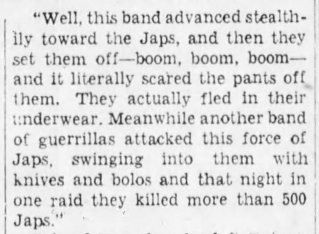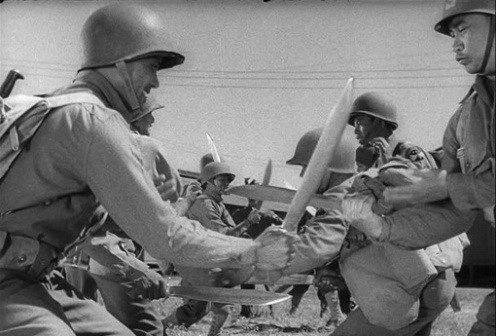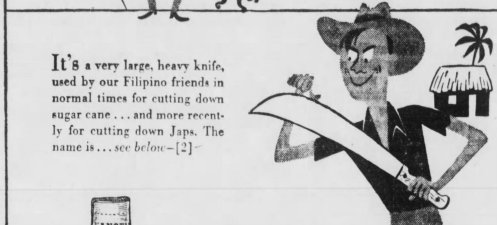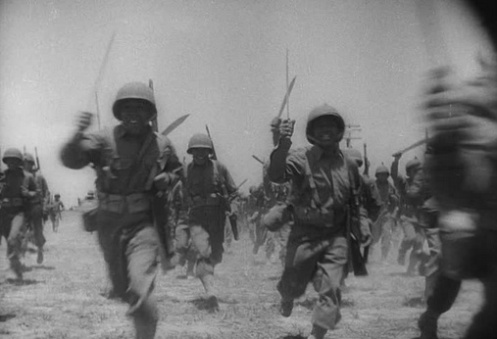Historic World War II Film Footage of Filipino Martial Arts Training with Bolo Knives
The following archival footage, recorded in 1943 during World War II, depicts the training of the Second Filipino Infantry Regiment with large bolo knives. It is one of the earlier, if not the earliest, film recording of the Filipino martial art of Arnis, or what some practitioners today refer to under the umbrella terms of Kali or Eskrima. Although the video could not be embedded here, one can view the high resolution clips in their entirety by clicking on the links below the images:
Source: http://footage.framepool.com/en/shot/347139581-bataan-filipino-filippin-soldier-filippine-military
Source: http://footage.framepool.com/en/shot/282829362-bataan-filipino-filippin-soldier-filippine-military Writer Antonio E. Somera gives the following information about the Second Regiment and its formation:
“During the outbreak of World War II many Filipinos volunteered for service. The outpouring was so creditable that orders were issued to activate the First Filipino Infantry Regiment in Salinas, Calif., effective July 13, 1942 and the Second Filipino Infantry Regiment Nov. 21, 1942. The First and Second Filipino Infantry was once one division with the strength of 12,000 men, three regiments, plus other special companies. In addition, out of these 12,000 men, about 1,000 were selected for special missions. This force of fighting Filipinos was known as the First Reconnaissance Battalion and was activated Nov. 20, 1944. This included the 978th signal service company, which was identified with the Allied Intelligence Bureau.These men and officers were called Commandos and “Bahala Na” (“come what may”) was their slogan. As part of General Douglas MacArthur’s secret force, they were dropped behind enemy lines and became the eyes and ears of General MacArthur.”
In the following interview, former soldier and member of the Second Regiment (and future Grandmaster) Leo Giron discusses the training that he and his fellow Filipino American soldiers received:
“We learned all the basic training needed for soldiering. Nothing special, just how to shoot a carbine, how to use a .45 and some basic hand-to-hand combat. I was fortunate to learn escrima as a child and later after coming to America with one of my most influential teachers, Flaviano Vergara. Flaviano taught me the most about escrima and how to defend myself. In fact, I met Flaviano a second time in Fort Ord during which time we would play on weekdays after dinner and on the weekends while everyone went into town. Flaviano and I would do nothing but drill and drill using estilo de fondo and larga mano. Sometimes a soldier would come by and ask what were we doing. Some would tell us that they would never come close to a Samurai sword. They claimed they would give the Samurai a load of their M-1…On Aug. 12, 1944 we boarded one of the smallest submarines in the United States Navy armada. It was called the U.S. Sting Ray. We were loaded and armed with carbines, submachine guns, side arms, bolo knives, trench knives, brass knuckles, ammunition and a few other special packages.”

Above: Leo Giron during World War II. Source: http://www.bahalana.org/gme-leo-giron
The question many might ask is, did members of the regiment ever use these bolos in earnest on the battlefield? The answer is a resounding “yes.” Giron proceeds to describe one of many encounters, this one involving the use of the bolo against a Japanese katana:
“One Bonsai attack comes to mind, in early June 1945 on a rainy day. A large number of enemy soldiers charged our position. We formed a wedge or triangle formation, two on the side and one as a point man. I was point man. Just like any Bonsai charge the enemy was always noisy. Yelling and shouting, they are not afraid to die. The Filipino guerrillas, on the other hand, chew their tobacco, grit their teeth and wing their bolos, chop here, jab there, long bolos, short daggers, pointed bamboo, pulverized chili peppers with sand deposited in bamboo tubes to spray so the enemy cannot see. By now my adrenaline must have gone up. One bayonet and samurai sword came simultaneously. The samurai sword was in front of me while the bayonet was a little to the left. With my left hand I parried the bayonet. I blocked the sword coming down on me. The bayonet man went by and his body came in line with my bolo. That’s when I came down to cut his left hip. The Samurai was coming back with a backhand blow. I met his triceps with the bolo and chopped it to the ground. After the encounter I wiped my face with my left hand to clear my eyes from the rain and found bloodstains on my face. There were many more encounters. But our job was not to be detected by the enemy; our mission was to send back vital information on the enemy to headquarters.”
In terms of his approach to the martial arts as a mentor and guru, Giron was also careful to explain the difference between a wartime and peacetime mentality: “I know the respect of the bolo knife. Wartime is different. There is no regard for life. It’s different teaching; you must have structure and good communications with your students. I like to teach more about the application and fundamentals. It’s not about how hard you hit or who is faster; it’s about sharing the art of our forefathers, because if you analyze it we are only the caretakers of the art for future generations….The only type of death match I had was during World War II. This is where I fought in the jungles for over a year, not knowing if we would survive. Our weapons of choice were the bolo knife or talonason, a long knife whose overall length is 36 inches long. No referee, no rules; the only rule was to survive.”

Above: Another WWII account of Filipinos with bolos, published in the Brooklyn Daily Eagle, August 1, 1942.
Original footage of the above at: http://footage.framepool.com/en/shot/871266769-bataan-filipino-filippin-soldier-filippine-military If you liked this article, you also might be interested in: Filipino versus Spanish Knife Fighters and a Duel in New York City, 1931 and Filipino Martial Arts Reported in a New York Newspaper, 1900







That was a “banzai” and not “bonsai” attack.
LikeLike
Good point, Lester. They often got foreign terms wrong in those old newspapers…
LikeLike
Awesome tribute to the Filipino Infantry ! Bahala Na
LikeLike
Thanks, Rocky!
LikeLike
Reblogged this on THE MARTIALXCHANGE.
LikeLike